The fluid or hydraulic coupling is a device used for transmitting power from the driving shaft to the driven shaft with the help of a fluid (generally oil). Whereas the hydraulic torque converter is a device used for transmitting increased torque at the driven shaft. There is no need for a mechanical connection between the two shafts. The main difference is that a hydraulic coupling does not change the torque or speed of the output shaft, while a hydraulic torque converter can increase the torque and decrease the speed of the output shaft. Let us discuss more details on Hydraulic Coupling and Torque Converters.
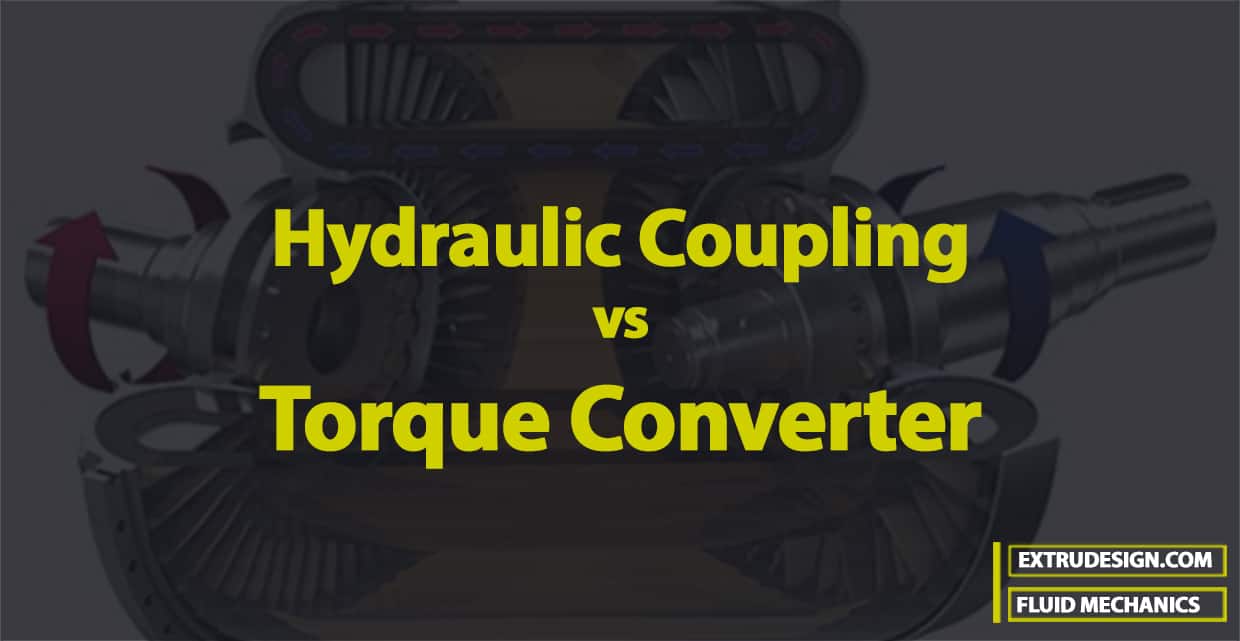
Fluid Systems
A fluid system is defined as a device in which power is transmitted with the help of a fluid which may be liquid (water or oil) or a gas (air) under pressure. Most of these devices are based on the principles of fluid statics and fluid kinematics. Following are the different devices that come under the Fluid systems.
- The hydraulic press
- The hydraulic accumulator
- The hydraulic intensifier
- The hydraulic Ram
- The hydraulic Lift
- The hydraulic Crane
- The fluid or hydraulic coupling
- The fluid or hydraulic torque converter
- The Air Lift pump
- The gear-wheel pump
Fluid Coupling / Hydraulic Coupling
The fluid or hydraulic coupling is a device used for transmitting power from the driving shaft to the driven shaft with the help of a fluid (generally oil). There is no mechanical connection between the two shafts. It consists of a radial pump impeller mounted on driving shaft A and a radial flow reaction turbine mounted on driving shaft B. Both the impeller and runner are identical in shape and they together form a casing which is completely enclosed and filled with oil. In the beginning, both shafts A and B are at rest. When the driving shaft Ais rotated, the oil starts moving from the inner radius to the outer radius of the pump impeller as shown in the following figure.
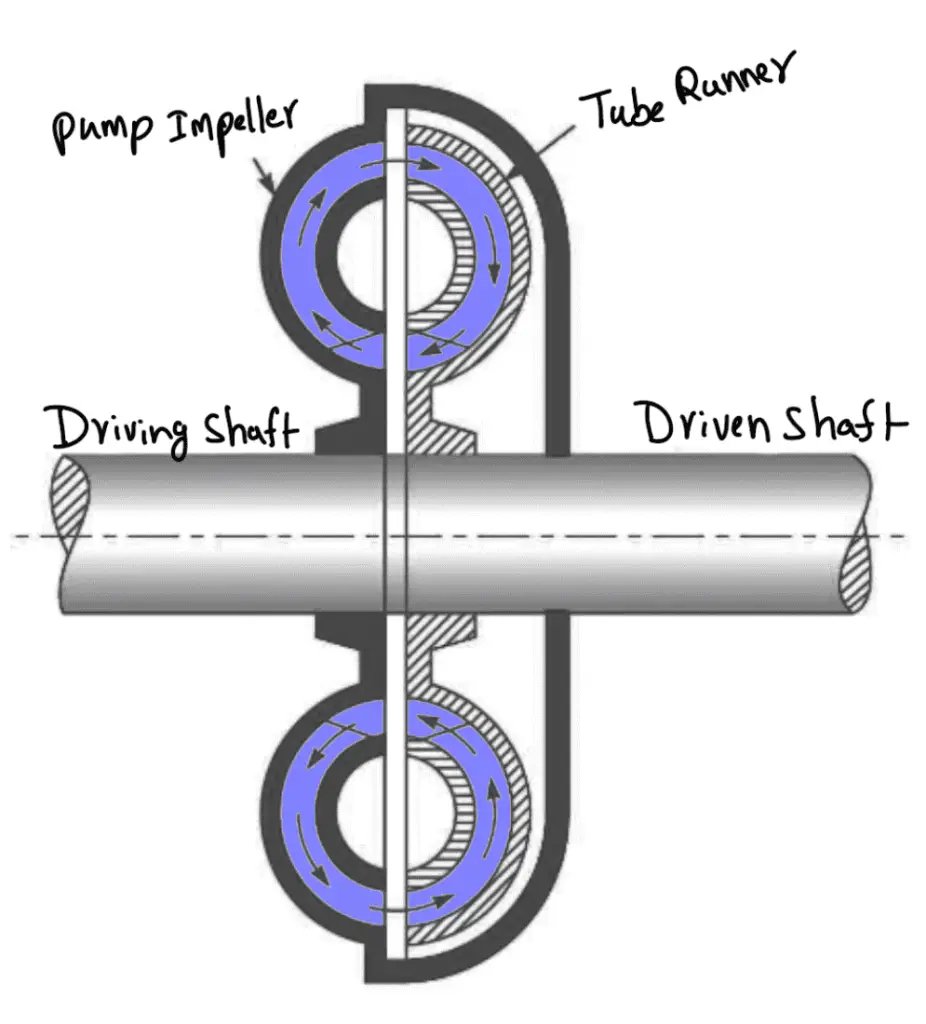
The pressure energy and kinetic energy of the oil increase at the outer radius of the pump impeller. This oil of increased energy enters the runner of the reaction turbine at the outer radius of the turbine runner and flows inwardly to the inner radius of the turbine runner. The oil, while flowing through the runner, transfers its energy to the blades of the runner and makes the runner rotate. The oil, from the runner, then flows back into the pump impeller, thus having a continuous circulation.
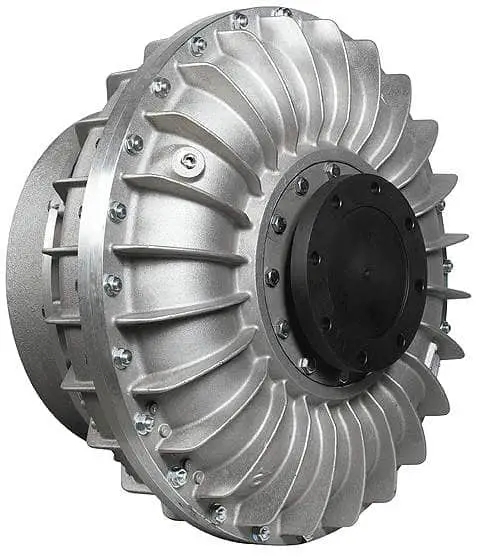
The power is transmitted hydraulically from the driving shaft to the driven shaft and the driven shaft is free from engine vibrations. The speed of the driven shaft B is always less than the speed of shaft A, by about 2%. The efficiency of the power transmission by hydraulic coupling is about 98%. This is derived as given below.
The efficiency of a fluid coupling = Power output ÷ Power input

…. Equation (a)
But the power at any shaft

…. Equation (b)
Let
NA = Speed of shaft A,
TA =Torque at shaft A,
NB = Speed of shaft B,
TB = Torque transmitted to shaft B.
From equation (b), we have
Power available to shaft A ∝ (Speed of shaft A) × Torque of A
PA ∝ NA × TA
Similarly, power transmitted to shaft B is PB ∝ NB × TB
Substituting these values of powers in equation (b), (∴ Transmitted torque is same so TA = TB)
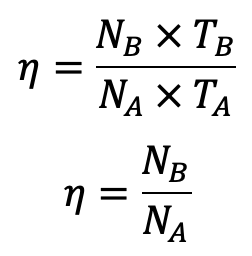
…. Equation (c)
Slip of fluid coupling is defined as the ratio of the difference of the speeds of the driving and driven
shaft to the speed of the driving sharp. Mathematically,
slip,
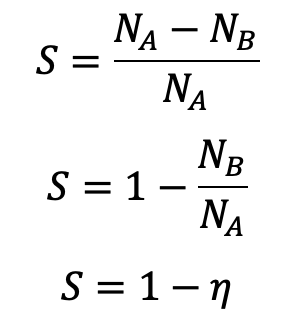
…. Equation (d)
This is the equation to calculate the amount of slip between the driving and the driven shaft since there is no mechanical connection.
Applications of Hydraulic Coupling
Hydraulic couplings are used to connect two shafts that require a flexible connection and a smooth transmission of power. They are often used in marine propulsion systems, conveyor drives, winches, drilling rigs, and railway locomotives.
Hydraulic Torque Converter
The hydraulic torque converter is a device that transmits increased torque at the driven shaft. The torque transmitted at the driven shaft may be more or less than the torque available at the driving shaft. The torque at the driven shaft may be increased about five times the torque available at the driving shaft with an efficiency of about 90%.
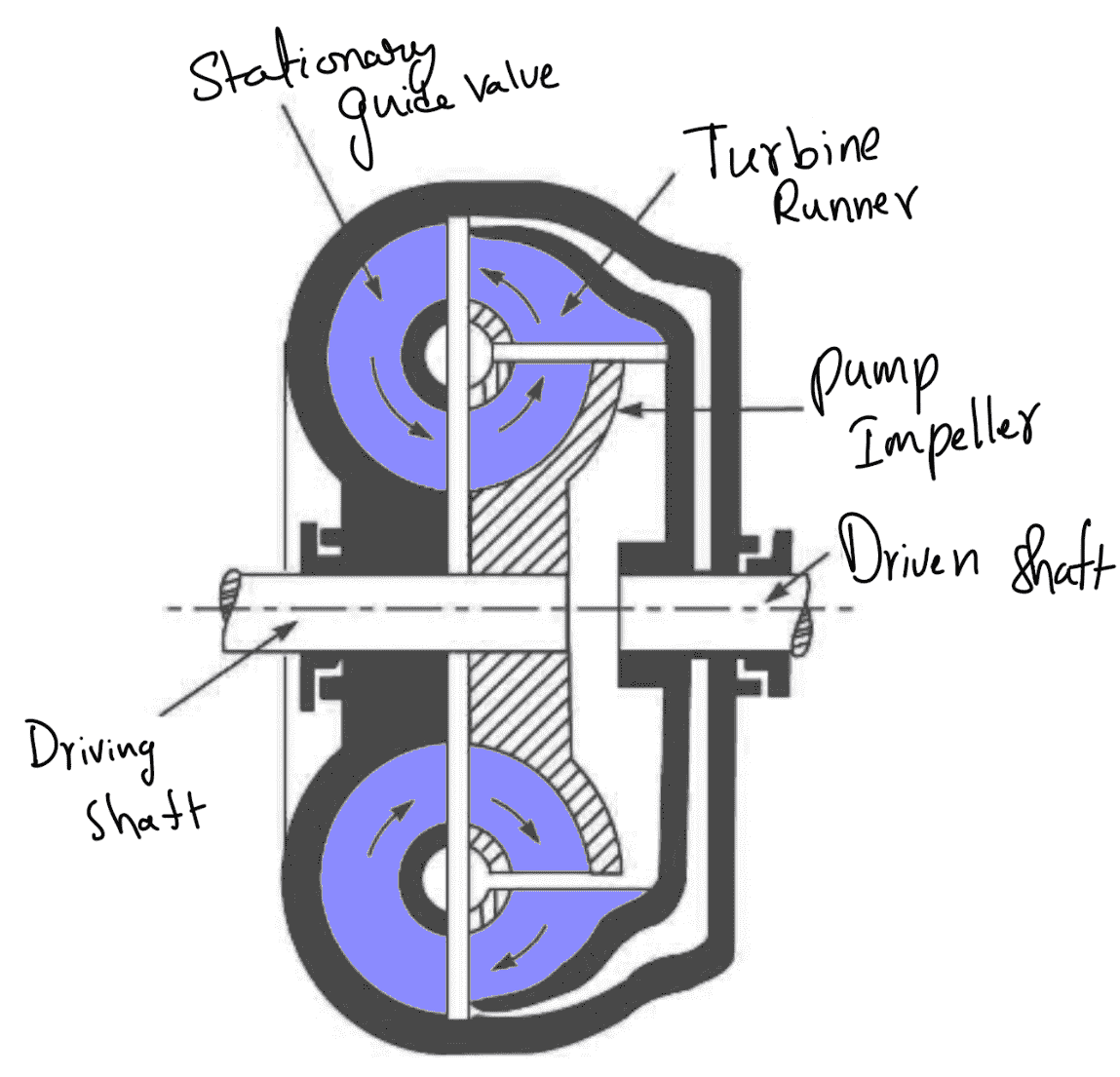
As mentioned above for the hydraulic Coupling, the power at any shaft is proportional to the product of torque and speed of the shaft. Hence, if the torque at the driven shaft is to be increased, the corresponding value of the speed at the same shaft should be decreased. The speed of the driven shaft is decreased by decreasing the velocity of oil, which is allowed to flow from the pump impeller to the turbine runner and then through stationary guide vanes as shown in the above figure. Due to the decrease in speed at the driven shaft, the torque increases.
Applications of Torque Converter
Torque converters are used to provide variable speed and torque multiplication for automatic transmissions. They are often used in the automotive industry, especially for passenger cars and forklifts. They are also used as soft starters for generators and gas or steam turbines.
Summary of Hydraulic Coupling vs Torque Converter:
A hydraulic coupling and a hydraulic torque converter are both devices that use fluid to transmit power from one shaft to another. The main difference is that a hydraulic coupling does not change the torque or speed of the output shaft, while a hydraulic torque converter can increase the torque and decrease the speed of the output shaft. A hydraulic coupling consists of two components: an impeller and a runner, which are both rotating vanes immersed in a fluid. The impeller is connected to the input shaft and drives the fluid, while the runner is connected to the output shaft and is driven by the fluid. Since there is no mechanical connection between the impeller and the runner, a hydraulic coupling does not transmit shocks and vibrations. A hydraulic torque converter is similar to a hydraulic coupling, with the addition of a stationary vaned member interposed between the runner and the impeller. This member is called a stator and it redirects the fluid flow to increase the torque on the output shaft. The stator also allows for a slip condition when the input shaft is rotating faster than the output shaft, which serves as a clutch mechanism for automatic transmissions.

Leave a Reply